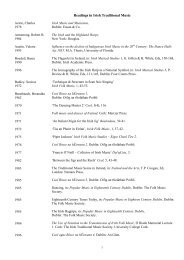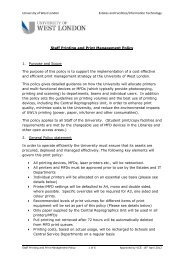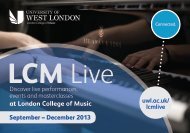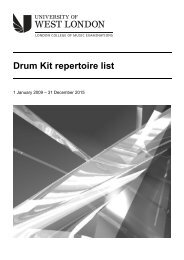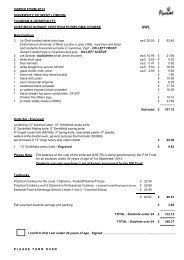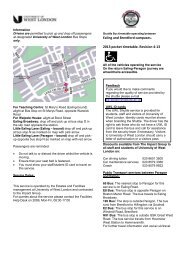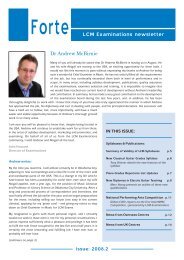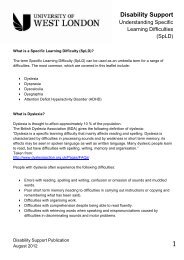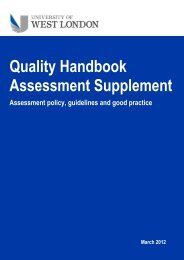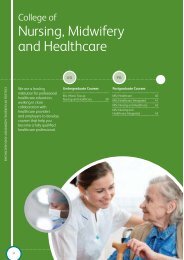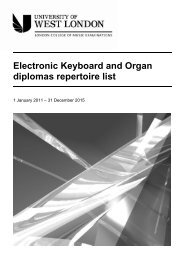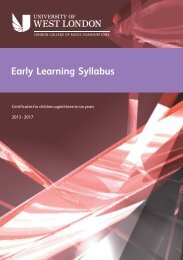LCM Exams - Jazz Diplomas Syllabus - University of West London
LCM Exams - Jazz Diplomas Syllabus - University of West London
LCM Exams - Jazz Diplomas Syllabus - University of West London
You also want an ePaper? Increase the reach of your titles
YUMPU automatically turns print PDFs into web optimized ePapers that Google loves.
Figure 8:<br />
<br />
<br />
<br />
<br />
<br />
<br />
<br />
<br />
<br />
<br />
<br />
<br />
<br />
<br />
<br />
<br />
A<br />
B<br />
C<br />
D<br />
A: MAJOR 7th Major scale, root to root<br />
B: DOMINANT 7th Major scale a perfect 4th above, root to root (MIXOLYDIAN)<br />
C: MINOR 7th Major scale a major 2nd below, root to root (DORIAN)<br />
D: HALF DIMINISHED 7th Major scale a minor 2nd above, root to root (LOCRIAN)<br />
Component 2: Transcriptions & vamps<br />
20 marks<br />
Candidates should perform TWO contrasting transcriptions, <strong>of</strong> their own choice. Transcriptions do NOT have<br />
to be played from memory.<br />
Alternatively, candidates may perform ONE transcription and THREE iconic vamps. The three vamps must be<br />
played from memory, as described above in the A<strong>LCM</strong> syllabus (Section 2.4.2, Component 2). Copies <strong>of</strong> the<br />
charts and recordings should be given to the examiners (as outlined above for A<strong>LCM</strong>).<br />
Component 3: Improvisations<br />
45 marks<br />
Candidates should present a ‘set’ <strong>of</strong> approximately 25 minutes’ duration. As at a pr<strong>of</strong>essional gig,<br />
presentation and programme building are important. These elements will be reflected in the marks. The<br />
programme may reflect variety, or follow a common theme. Candidates should feel free to explore any style,<br />
ranging from the blues and ragtime through to the contemporary.<br />
Component 4: (a) Sight reading test, (b) Reading from a lead sheet<br />
15 marks<br />
(a) Sight reading test<br />
The sight reading test may be written in any jazz style. Small sections may require improvisation; however,<br />
chord indications will be given (eg. chord two in C major may appear as Dm7, D-7 or ii7).<br />
Creative voicing is encouraged. Fluency and rhythmic consistency are priorities, more so than including every<br />
written note.<br />
One minute’s preparation time will be given; during this time candidates may ‘try out’ small sections <strong>of</strong> the<br />
music, but they may not play the whole piece through from beginning to end.<br />
(b) Reading from a lead sheet<br />
Before the exam begins the candidate will be given a copy <strong>of</strong> a lead sheet (in the style <strong>of</strong> a Real Book or<br />
Aebersold book). Ten minutes will be given for study/practice. The style will be indicated by the examiner(s).<br />
Performance during the exam should include appropriate styling, and voicing, and the candidate may also<br />
wish to explore skills related to the rhythm section pianist (eg. comping, vamping, sympathetic fills, etc.).<br />
Component 5: Discussion<br />
10 marks<br />
As for A<strong>LCM</strong> above, but a greater depth will be expected (eg. awareness <strong>of</strong> more complex chords). A good<br />
depth <strong>of</strong> knowledge relating to the styles represented in the programme is required.<br />
17




